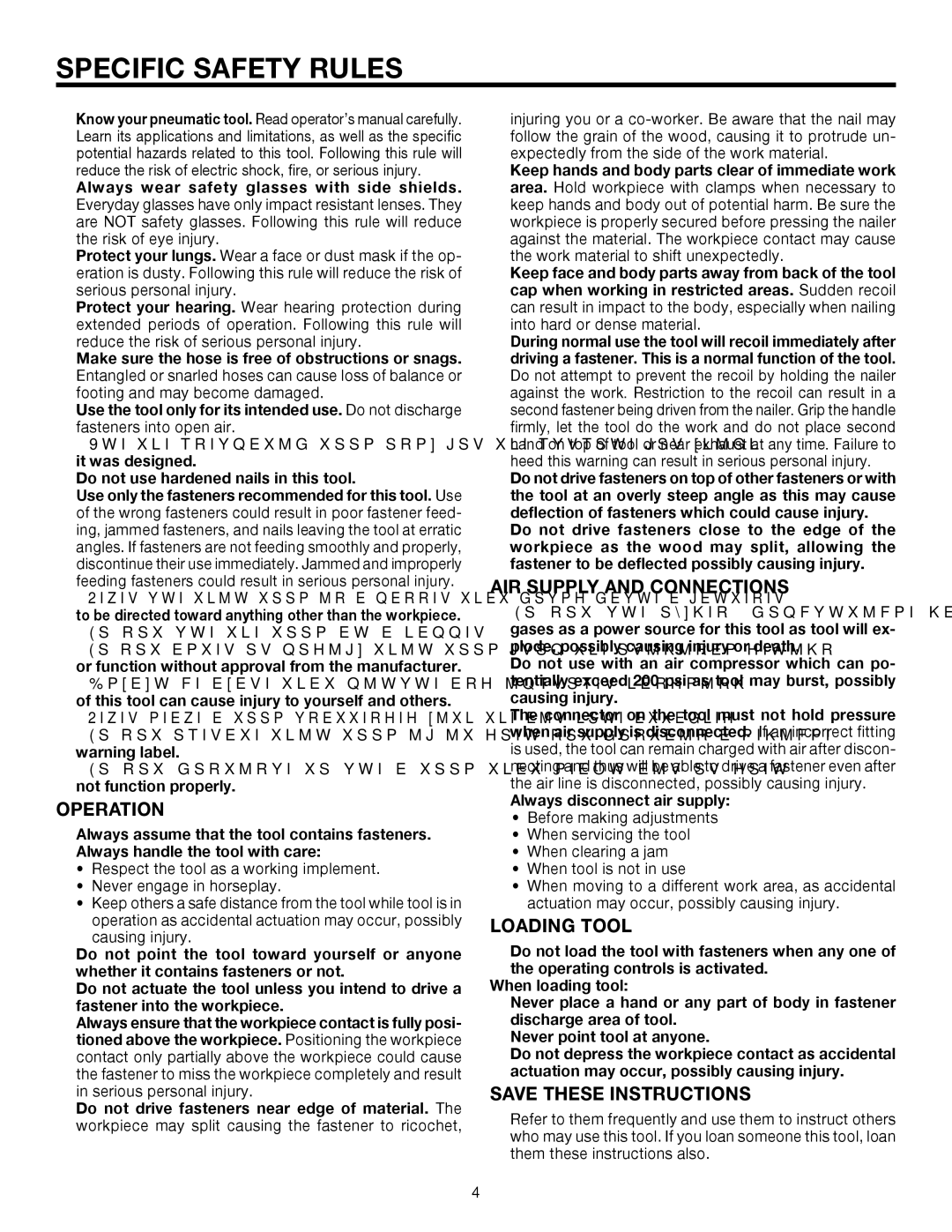SPECIFIC SAFETY RULES
Know your pneumatic tool. Read operator’s manual carefully. Learn its applications and limitations, as well as the specific potential hazards related to this tool. Following this rule will reduce the risk of electric shock, fire, or serious injury.
Always wear safety glasses with side shields. Everyday glasses have only impact resistant lenses. They are NOT safety glasses. Following this rule will reduce the risk of eye injury.
Protect your lungs. Wear a face or dust mask if the op- eration is dusty. Following this rule will reduce the risk of serious personal injury.
Protect your hearing. Wear hearing protection during extended periods of operation. Following this rule will reduce the risk of serious personal injury.
Make sure the hose is free of obstructions or snags. Entangled or snarled hoses can cause loss of balance or footing and may become damaged.
Use the tool only for its intended use. Do not discharge fasteners into open air.
Use the pneumatic tool only for the purpose for which it was designed.
Do not use hardened nails in this tool.
Use only the fasteners recommended for this tool. Use of the wrong fasteners could result in poor fastener feed- ing, jammed fasteners, and nails leaving the tool at erratic angles. If fasteners are not feeding smoothly and properly, discontinue their use immediately. Jammed and improperly feeding fasteners could result in serious personal injury.
Never use this tool in a manner that could cause a fastener to be directed toward anything other than the workpiece.
Do not use the tool as a hammer.
Do not alter or modify this tool from the original design or function without approval from the manufacturer.
Always be aware that misuse and improper handling of this tool can cause injury to yourself and others.
Never leave a tool unattended with the air hose attached.
Do not operate this tool if it does not contain a legible warning label.
Do not continue to use a tool that leaks air or does not function properly.
operation
Always assume that the tool contains fasteners.
Always handle the tool with care:
•Respect the tool as a working implement.
•Never engage in horseplay.
•Keep others a safe distance from the tool while tool is in operation as accidental actuation may occur, possibly causing injury.
Do not point the tool toward yourself or anyone whether it contains fasteners or not.
Do not actuate the tool unless you intend to drive a fastener into the workpiece.
Always ensure that the workpiece contact is fully posi- tioned above the workpiece. Positioning the workpiece contact only partially above the workpiece could cause the fastener to miss the workpiece completely and result in serious personal injury.
Do not drive fasteners near edge of material. The workpiece may split causing the fastener to ricochet,
injuring you or a
Keep hands and body parts clear of immediate work area. Hold workpiece with clamps when necessary to keep hands and body out of potential harm. Be sure the workpiece is properly secured before pressing the nailer against the material. The workpiece contact may cause the work material to shift unexpectedly.
Keep face and body parts away from back of the tool cap when working in restricted areas. Sudden recoil can result in impact to the body, especially when nailing into hard or dense material.
During normal use the tool will recoil immediately after driving a fastener. This is a normal function of the tool. Do not attempt to prevent the recoil by holding the nailer against the work. Restriction to the recoil can result in a second fastener being driven from the nailer. Grip the handle firmly, let the tool do the work and do not place second hand on top of tool or near exhaust at any time. Failure to heed this warning can result in serious personal injury.
Do not drive fasteners on top of other fasteners or with the tool at an overly steep angle as this may cause deflection of fasteners which could cause injury.
Do not drive fasteners close to the edge of the workpiece as the wood may split, allowing the fastener to be deflected possibly causing injury.
AIR SUPPLY AND CONNECTIONS
Do not use oxygen, combustible gases or bottled gases as a power source for this tool as tool will ex- plode, possibly causing injury or death.
Do not use with an air compressor which can po- tentially exceed 200 psi as tool may burst, possibly causing injury.
The connector on the tool must not hold pressure when air supply is disconnected. If an incorrect fitting is used, the tool can remain charged with air after discon- necting and thus will be able to drive a fastener even after the air line is disconnected, possibly causing injury.
Always disconnect air supply:
•Before making adjustments
•When servicing the tool
•When clearing a jam
•When tool is not in use
•When moving to a different work area, as accidental actuation may occur, possibly causing injury.
loading tool
Do not load the tool with fasteners when any one of the operating controls is activated.
When loading tool:
Never place a hand or any part of body in fastener discharge area of tool.
Never point tool at anyone.
Do not depress the workpiece contact as accidental actuation may occur, possibly causing injury.
Save these instructions
Refer to them frequently and use them to instruct others who may use this tool. If you loan someone this tool, loan them these instructions also.
